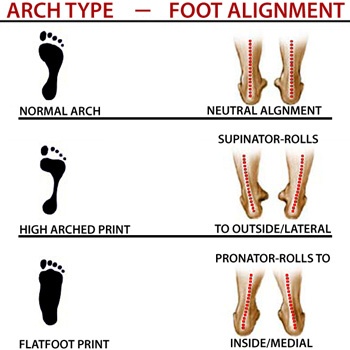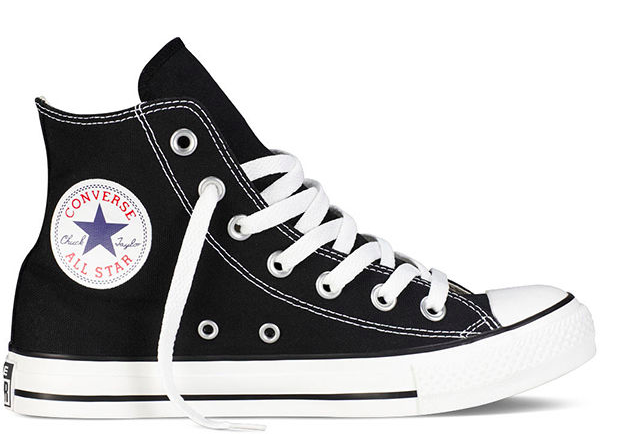There are many terms used to describe feet and foot types. The most general and common are ‘Pes Planus’ (flat foot) and ‘pes cavus’ (high arched foot). A ‘normal’ foot, between the two, is known as ‘rectus’. ‘Pronation’ (rolling in) is normal and required by the body to shock absorb and adapt to different surfaces. ‘Supination’ (rolling out) is also ‘normal’ at times in the gait cycle and the foot needs to ‘resupinate’ once it has absorbed the shock of the footstep by pronating.
As mentioned pronation is the body’s way to absorb shock and adapt to the surfaces, as this suggests the foot is very flexible when in a pronated position and during this stage of the footstep the foot is often referred to as a mobile adaptor.
In order for the foot to transfer forces and propel the body it needs to resupinate so that it is stiff enough to transfer the forces generated by the muscles to the ground. At this stage of the footstep the foot is often referred to as a rigid lever. Thus in ‘normal’ foot function the foot will pronate to act as a shock absorber and then resupinate to act as a rigid lever for propulsion.
Barefoot training and foot mechanics for the unmechanically mindeD
Pes planus is often associated with excess pronation. If there is too much pronation present there can be issues due to excess stress on certain tissues in the foot and leg. The tissue that breaks down first due to the excess, abnormal forces is the one in which the sufferer will experience problems. This varies between individuals but is always the weakest tissue. It can be bone, ligament, muscle or tendon but is most commonly ligament or muscle. The tissue breaks down because it is being over worked by too much force or by sustaining this force for too long. The second of the two is regularly seen in people who have just started training or changed the training dramatically so the body’s tissues are not accustomed to the new load and have not yet adapted to be able to sustain the new workload required of them. To prevent this from occurring the pronation needs to be controlled and training needs to be increased appropriately. Excess pronation in a foot can also mean that it cannot resupinate and thus will not be effective in transferring the forces. This will mean that much of the power generated by the muscles in the leg and the foot will be wasted and dissipated through the foot instead of being transferred through the foot onto the ground. This inefficient walking and running will commonly be described as ‘apropulsive’ (lacking propulsion).
Pes cavus feet, depending on the degree of ‘cavus’, are in a supinated position. Often they do not have the ability to properly pronate and thus people with this foot type do not shock absorb effectively and have much more force through the foot, leg and body. It stands to reason that these people, instead of suffering the muscular overuse type of injuries seen in people with pes planus, will suffer more bony type over use injuries such as stress fractures. As is the case with pes planus these people often suffer their injuries after a training change or start of training, again as a result of new forces the body is not accustomed too.

If there is excessive pronation present podiatrists will often attempt to control this by using shoes with features aimed at ‘control’ and sometimes use of orthotics. The features of these shoes regularly include a higher density material or even plastic on the inside of the shoe to stop the motion of the foot (Appendix 1). This is in contrast to shoes used for people that are under pronating (usually those with a pes cavus foot type) which usually have very soft materials used in the sole. This is aimed at increasing the shock absorbing properties of the shoes to compensate for a lack of shock absorbing qualities in the foot. These shoes are often said to be ‘cushioning’ or have ‘cushioning features’ (Appendix 2). In either foot type a podiatrist might need to use orthotic devices to help alter the way in which the foot functions. This is done with a variety of modifications and materials and orthotics come in all shapes and sizes. The orthotics are used in conjunction with the properties of the shoes they will be used in so that the end result is one of ideal foot function. Thus if a person is in a very controlling shoe the orthotics made for them will most likely be less controlling than if they were in a shoe that controlled their foot motion less and visa versa. The summative effect of the orthotic devices and the shoes is what is desired by the podiatrist to ensure that foot mechanics are optimal.
Recently there has been a push towards minimalistic footwear and barefoot training. The reason for this is that previously there has been a tendency for people to be in shoes that are excessively controlling for their foot type. Being in a shoe that is excessively controlling means that the intrinsic muscles in the foot do not have to work as hard and thus atrophy and become weaker. This will result in worse mechanics of the foot when not in the shoes. Using shoes the like ‘Nike free'(Appendix 6) or ‘Vibram Five Fingers’ (Appendix 7) to simulate barefoot training and walking or being barefoot for training can be likened to doing a gym session, but for the feet. Stimulus is used to achieve a desired gain in strength. This, like gym, can be done inappropriately though. As in the gym the load used needs to be monitored and be appropriate. Just as one wouldn’t bench press 100kg having not done the lift in years one must be careful not to start barefoot training if your foot mechanics are bad and you are used to being in controlling shoes. An appropriate load of someone in very controlling shoes and orthotics might be as simple as wearing the shoes without the orthotics. This stimulus might be enough to strengthen the intrinsic muscles of the foot without placing excessive stress on the tissues. Barefoot training in a foot that has poor mechanics and is not strong enough may result in overuse injuries such as stress fractures or muscle strains. In addition to this, if the intrinsic muscles of the foot are not able to hold the foot in an appropriate position there can be issues with balance. Within the body there are information receptors called proprioceptors, which send messages to the brain, for example where a specific joint is or how long a specific muscle is. The proprioceptors in the intrinsic muscles of the foot are amongst the highest density of the whole body and thus if the information to these is inappropriate due to the poor mechanics of the foot coordination can be adversely effected.
This trend in minimalistic footwear and barefoot training has also been carried over to resistance training. This is for more than just the ‘workout’ that the muscles in the foot receive though. When performing resistance training exercises, more commonly those for the lower body, maximal energy efficiency is required for optimal performance. Thus shoes that are made for shock absorption (which all running shoes are, albeit to differing extents) would dissipate some of the energy/force provided by the leg muscles to lift the weight through their compression. This means that the individual lifting the weight is losing some of the force being provided by the leg muscles due to his or her poor choice of footwear.

Old School Chuck Taylors – Great for Gym
To combat this, power lifters commonly use ‘Chuck Taylors’, aka converse all stars (Appendix 3). This is due to their thin sole which is very hard. These are great and are very similar to the Dunlop volley, but the issue for some is that these shoes have no extra height at the heel. In modern day society when people are wearing shoes all day (almost all of which will have a heel which is higher than the forefoot, known as a positive heel angle) this will pose a problem as these individuals are not accustomed to functioning with their heel and forefoot on the same plane. Effectively due to their habits, being with heel and forefoot on the same angle gives them a relative negative heel angle. This can often also impair depth of squats as dorsiflexion range of motion at the ankle is frequently diminished in these individuals. Weightlifters (athletes competing in the snatch and clean and jerk) commonly use weightlifting boots, which do have a positive heel angle. The soles of these are made of wood and thus do not dissipate the force allowing for maximum efficiency (Appendix 4). Another alternative is the use of tennis shoes. The nature of tennis courts means that these are made with extremely hard soles do ensure they are durable enough to endure the gruelling requirements of the sport. These too have a positive heel and allow for slightly more athleticism than do weightlifting boots when it comes to activities such as plyometrics. That being the case, it is largely inconsequential for the recreational gym user who is not particularly concerned with maximal effort squats and the like. Even fairly serious lifters often prefer to lift barefoot than bother with some of the higher level footwear described above.
Barefoot training, or rather training the intrinsic muscles of the foot by using shoes with less control is an essential part of maintaining good foot health and function. This should be done carefully via using appropriate ‘loads’ (or changes in shoes) to ensure that injury is avoided and maximum gain can still be obtained. Using appropriate shoes for training, especially running, is also extremely important to stay injury free. Shoe companies generally have information regarding their shoes and the features of the shoes, which is available on websites and in catalogues. When buying shoes ensure that that these features are what is required of your foot type.
By David Lipman
References
Appendix 1: http://www.tootsies.ca/files/imagecache/shoe_fullpage/files/mens%20Brooks%20Beast.jpg
‘Control Shoe’, with heavy medial posting. It has a higher density midsole AND plastic to reinforce the area also.
Appendix 2: http://2.bp.blogspot.com/_0-bUtGyU7Lg/SDTRZ-Lg9oI/AAAAAAAAAMo/1ky992XGH_Q/s320/Asics+Gel+Nimbus+10.jpg
‘Cushion Shoe’, no medial posting. Soft midsole to allow for cushioning.
Appendix 3: http://www.elitesexpressed.com/wp-contenthttp://www.fitnance.com.au/uploads/2009/08/Converse-All-Star-Black.jpg
‘Chuck Taylors’ aka ‘Converse All Stars’. Minimal thickness to the sole. Forefoot and heel on the same plane.
Appendix 4: http://1.bp.blogspot.com/_MjKWWAeV7QI/SchTCQRN1fI/AAAAAAAAAo8/wuxZBjdZ8kk/s400/weightlifting-shoes-731637.jpg
Weightlifting boots. Wooden sole for minimal force dissipation. Positive heel angle.
Appendix 5: http://di1.shopping.com/images1/pi/83/c1/20/31137054-300×300-0-0_Adidas_Adidas_Barricade_Iv.jpg
Tennis Shoe. Positive heel angle. Hard sole, with plastic through it to increase stiffness.
Appendix 6: http://www.geeksneakers.com/wp-content/gallery/140/nike-free-shoes-6.jpg
Nike Free. Flexible sole, allowing for maximal movement-simulating being barefoot.
Appendix 7: http://image3.examiner.com/images/blog/wysiwyg/image/vibram_fivefingers.jpg
Vibram Five Fingers. Flexible, Minimal sole. Individual toes.
